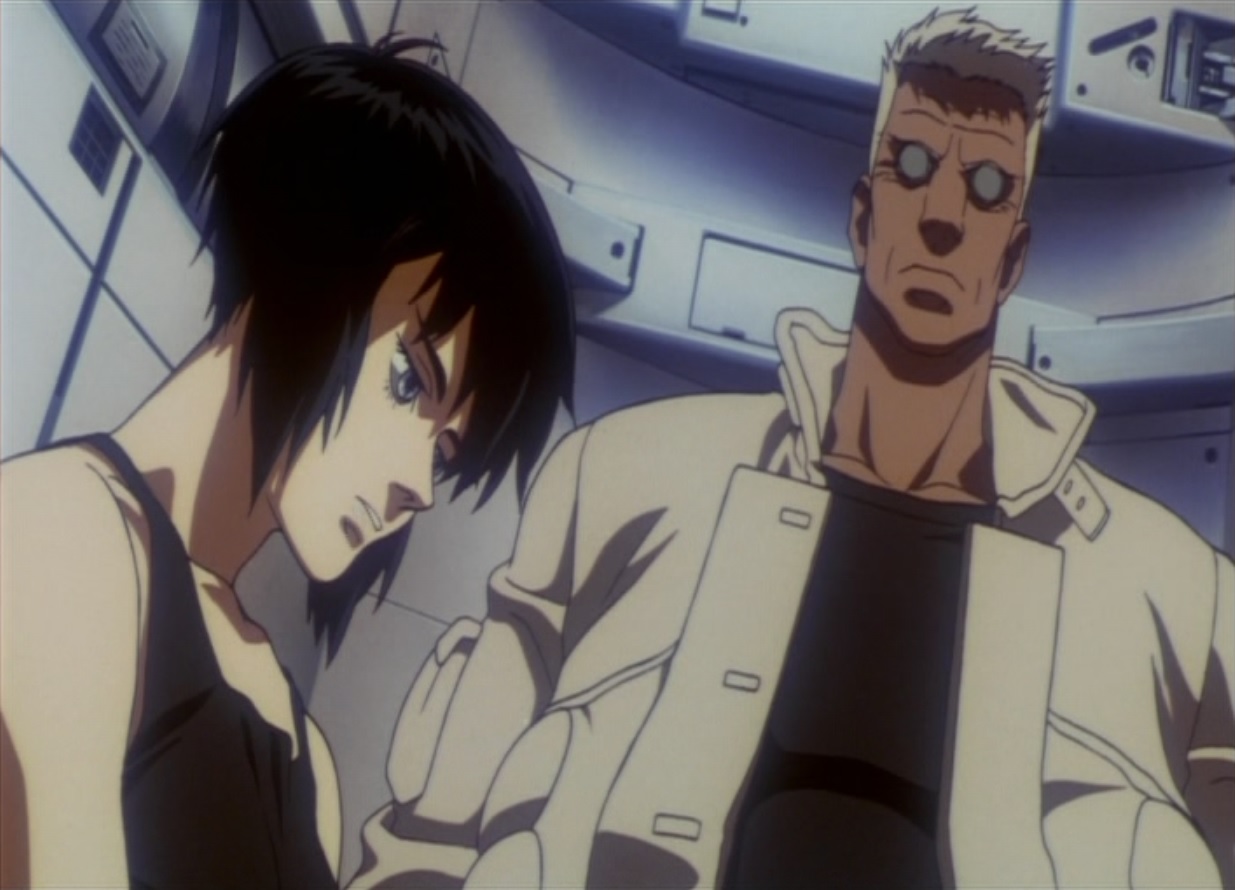You are currently browsing the tag archive for the ‘cyborg’ tag.
Director: Mamoru Oshii
Release Date: November 18, 1995
Rating: ★★★½
Review:

‘Ghost in the Shell’ was the best known anime film in the West between ‘Akira’ (1988) and ‘Spirited Away’ (2001). This was of course mainly because it was one of the very few Japanese features being released in the West in the first place. But what also helped was that the film merges science fiction, action thriller and philosophy into an entertaining melting pot, which a sexy cyborg as its main star.
‘Ghost in the Shell’ is based on a manga by Masamune Shirow and tells about major Motoko Kusanagi, a female cyborg, who has to track down a dangerous hacker called the ‘Puppet Master’. But when the true identity of the Puppet Master is revealed, things take a whole different turn…
The plot of ‘Ghost in the Shell’ is complex and very hard to follow. It doesn’t help that the future world in which it takes place is introduced with a minimum of background story, thus the viewer has to grab the relevant information along the way. For example, only gradually it became clear to me that practically every citizen in this future world has augmented brains, and is therefore hackable. Or that Kusanagi wasn’t an android, as I thought, but a cyborg, although we don’t see any biological tissue on her. In fact, already within the first two minutes we see her naked, with clearly defined breasts, but no genitals whatsoever, looking strangely like a Barbie doll instead.
‘Ghost in the Shell’ is a true cyberpunk film, and revolves around the idea of artificial intelligence and what it means to be human or to be alive. Not only does the main plot focuses on those ideas, there are several, often rather pompous dialogues between Kusanagi and her partner, the muscular fellow cyborg Bateau, in which the two ponder the meaning of their own existence. A lot of attention goes to the mysterious ‘ghost’ within the wired neural networks, a word that the Japanese use untranslated, and which points directly to Arthur Koestler’s ‘the ghost in the machine’ (1967). The Japanese ‘Ghost’ is translated back into ‘soul’ in the subtitles, but its precise concept remains vague, and in the end both the story and these bits of dialogue are much too thin to call ‘Ghost in the Shell’ a philosophical masterpiece, for despite all the philosophical implications the film is an action thriller first and foremost.
Nevertheless, I suspect the feature was an influence on the makers of ‘The Matrix’, for it foreshadows some of the latter film’s themes, and ‘The Matrix’ quite clearly stole both the connection to the network by neck and the theme of green numbers filling the screen from ‘Ghost in the Shell’.
As a thriller the film delivers, featuring spectacular manhunts, several shootings and fights, a few bits of gross violence, and an exciting finale in an abandoned natural history museum, a setting deliberately chosen to enhance the movie’s theme of new developments within human and non-human evolution. The action is greatly helped by excellent staging and by solid background art, supervised by Takashi Watabe, evoking a partly drowned, and partly abandoned metropolis containing many different nationalities, not unlike the world of ‘Blade Runner’ (1982).
Also strong is Kenji Kawai’s musical soundtrack, which uses electronics, percussion and haunting choirs to a unique and unsettling effect. Around 35 minutes there’s even a more than a minute long gorgeous mood piece, consisting of townscapes and music only, which is pure atmosphere, and completely unnecessary to the plot.
Much less impressive is the animation, supervised by Hiroyuki Okiura. Compared to ‘Akira’ or contemporary output by the Ghibli studio, the animation in ‘Ghost in the Shell’ looks cheap and low-budget. There are many scenes in which there’s hardly to no animation at all, especially during the dialogue scenes, and talking is suggested by a bare minimum of means. For example, there’s a shot of Kusanagi talking that uses only two drawings in rapid succession. Even worse, the cyborgs can talk to each other without speaking, leaving several scenes totally unanimated. This is too bad, for when there’s more effort placed into the animation, it’s actually quite good. Especially a complex scene in a crowded market place stands out as a great piece of animated action, as does the final battle between the colonel and a robot tank. The 2d animation is often combined with rather primitive computer animation, which may have looked quite cool then, but which hasn’t aged very well. Most impressive is the use of CGI in the camouflage suits.
The character designs, too, also by Okiura, leave much to be desired. The characters are very generic, and rather angular, and lack the appeal of those in contemporary Ghibli or Otomo films. Kusanagi is hardly the sexy heroine she’s supposed to be, and often looks uncannily masculine. At least the Western characters are distinguishable from the Asian ones, a rather rare feat in anime.
Thus ‘Ghost in the Shell’ may disappoint the pure animation lovers, but will delight those interested in Japanese science fiction and cyborg themes. As such it’s a film that has aged surprisingly well. Even better, the feature’s relevance has only grown since then, as the real world has been rapidly moving towards the future depicted in the film.
In 2004 ‘Ghost in the Shell’ was followed by a sequel, ‘Ghost in the Shell 2: Innocence, and in 2017 by a live action version, starring Scarlett Johansson as the major.
Watch the trailer for ‘Ghost in the Shell’ yourself and tell me what you think:
‘Ghost in the Shell’ is available on Blu-Ray and DVD
